Essay: Rise, Spread, and Characteristics of Renaissance Humanism
VerifiedAdded on 2022/08/24
|10
|2805
|31
Essay
AI Summary
This essay delves into the intellectual movement of Renaissance Humanism, which emerged in the 13th century and significantly shaped European thought. It examines the movement's foundation in classical texts, its spread across Western Europe, and its departure from medieval thinking. The essay highlights factors influencing the rise and spread of Renaissance Humanism, emphasizing the shift towards rationalism, secularism, and individualism. It explores the roles of key figures like Francesco Petrarch and the impact of the printing press on disseminating humanist ideas. The essay also discusses the characteristics of Renaissance Humanism, including its focus on classical Greek and Roman texts, the rebirth of individualism, and its influence on various fields such as art, science, and education. Furthermore, the essay addresses the critical perspectives and the evolution of humanist thought in different European regions during the 16th century, providing a comprehensive overview of this transformative period.
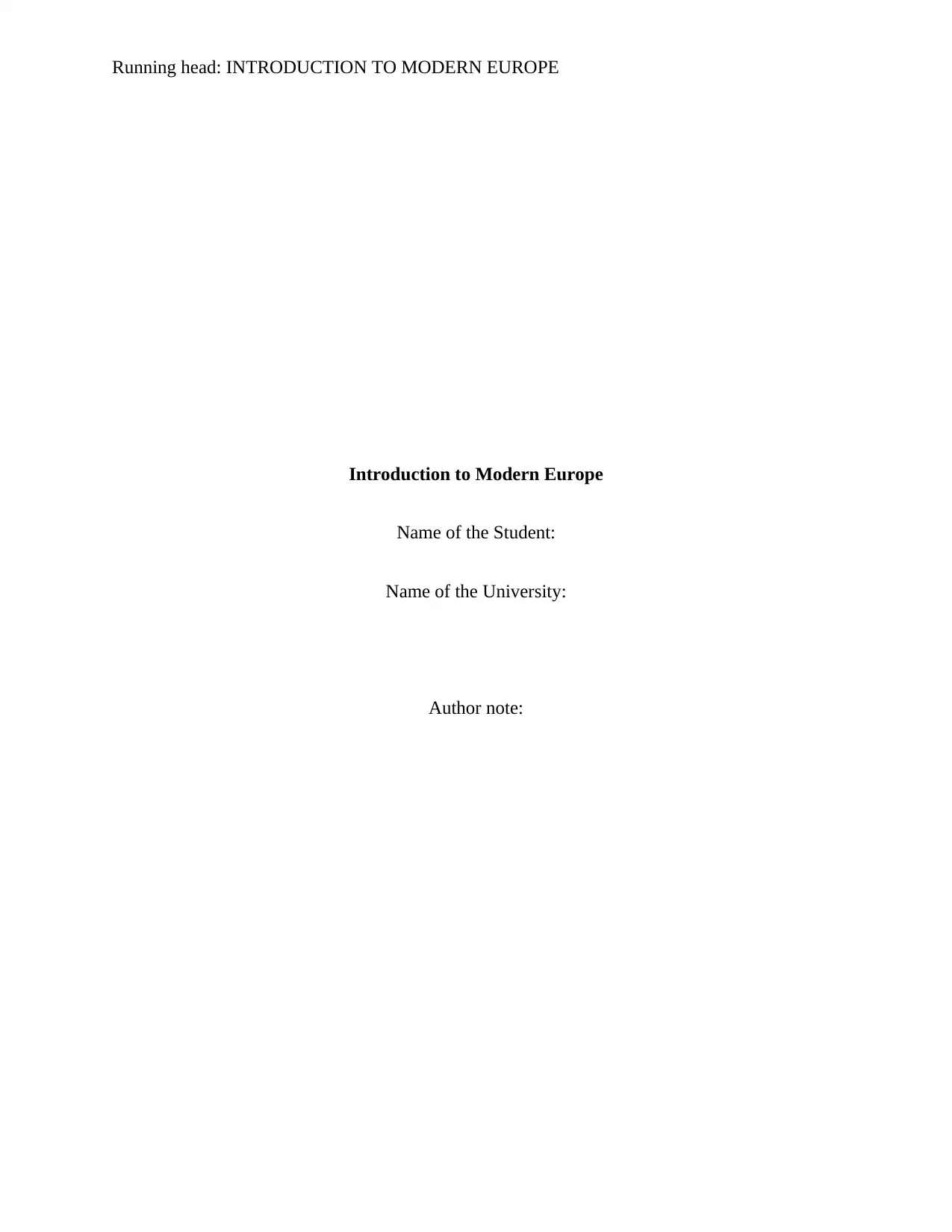
Running head: INTRODUCTION TO MODERN EUROPE
Introduction to Modern Europe
Name of the Student:
Name of the University:
Author note:
Introduction to Modern Europe
Name of the Student:
Name of the University:
Author note:
Paraphrase This Document
Need a fresh take? Get an instant paraphrase of this document with our AI Paraphraser
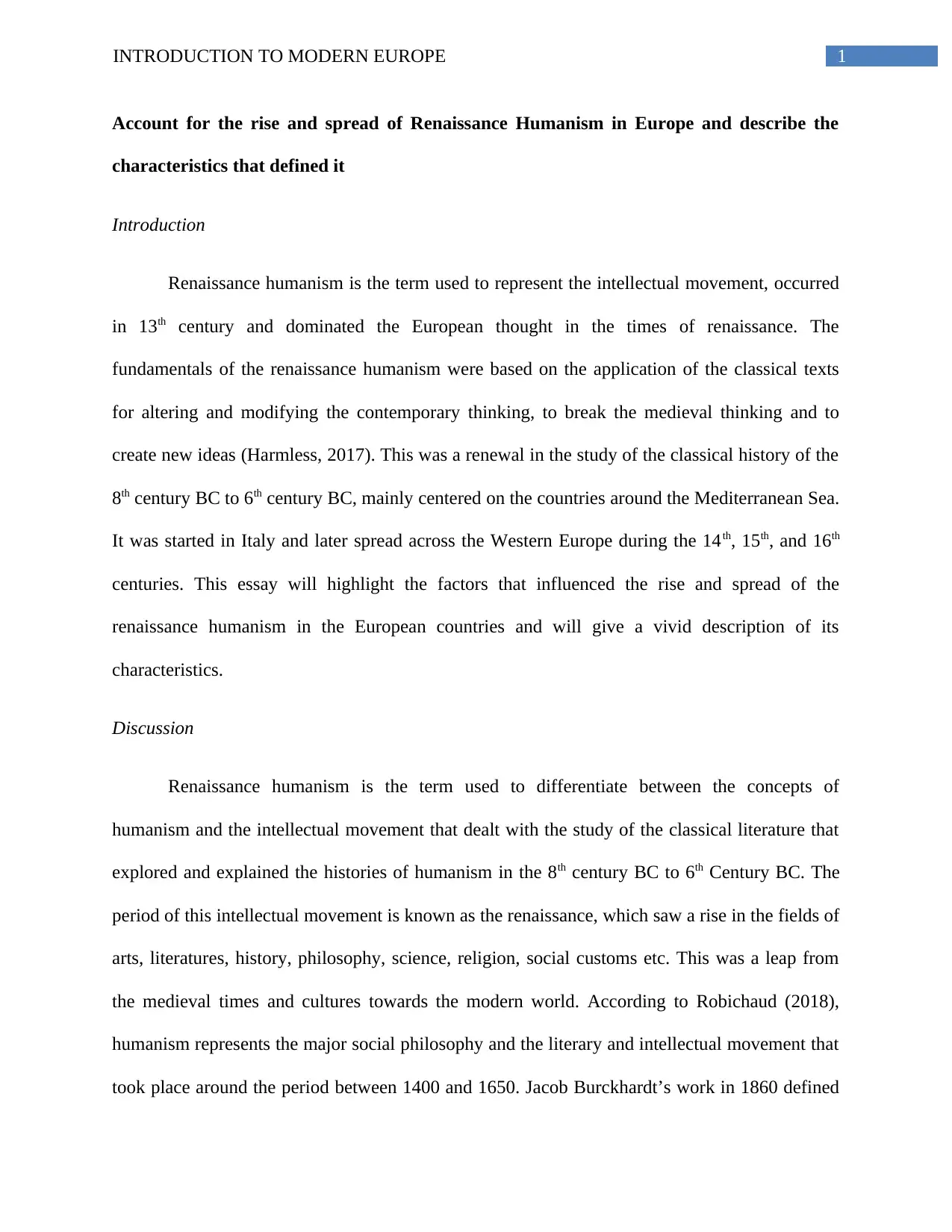
1INTRODUCTION TO MODERN EUROPE
Account for the rise and spread of Renaissance Humanism in Europe and describe the
characteristics that defined it
Introduction
Renaissance humanism is the term used to represent the intellectual movement, occurred
in 13th century and dominated the European thought in the times of renaissance. The
fundamentals of the renaissance humanism were based on the application of the classical texts
for altering and modifying the contemporary thinking, to break the medieval thinking and to
create new ideas (Harmless, 2017). This was a renewal in the study of the classical history of the
8th century BC to 6th century BC, mainly centered on the countries around the Mediterranean Sea.
It was started in Italy and later spread across the Western Europe during the 14th, 15th, and 16th
centuries. This essay will highlight the factors that influenced the rise and spread of the
renaissance humanism in the European countries and will give a vivid description of its
characteristics.
Discussion
Renaissance humanism is the term used to differentiate between the concepts of
humanism and the intellectual movement that dealt with the study of the classical literature that
explored and explained the histories of humanism in the 8th century BC to 6th Century BC. The
period of this intellectual movement is known as the renaissance, which saw a rise in the fields of
arts, literatures, history, philosophy, science, religion, social customs etc. This was a leap from
the medieval times and cultures towards the modern world. According to Robichaud (2018),
humanism represents the major social philosophy and the literary and intellectual movement that
took place around the period between 1400 and 1650. Jacob Burckhardt’s work in 1860 defined
Account for the rise and spread of Renaissance Humanism in Europe and describe the
characteristics that defined it
Introduction
Renaissance humanism is the term used to represent the intellectual movement, occurred
in 13th century and dominated the European thought in the times of renaissance. The
fundamentals of the renaissance humanism were based on the application of the classical texts
for altering and modifying the contemporary thinking, to break the medieval thinking and to
create new ideas (Harmless, 2017). This was a renewal in the study of the classical history of the
8th century BC to 6th century BC, mainly centered on the countries around the Mediterranean Sea.
It was started in Italy and later spread across the Western Europe during the 14th, 15th, and 16th
centuries. This essay will highlight the factors that influenced the rise and spread of the
renaissance humanism in the European countries and will give a vivid description of its
characteristics.
Discussion
Renaissance humanism is the term used to differentiate between the concepts of
humanism and the intellectual movement that dealt with the study of the classical literature that
explored and explained the histories of humanism in the 8th century BC to 6th Century BC. The
period of this intellectual movement is known as the renaissance, which saw a rise in the fields of
arts, literatures, history, philosophy, science, religion, social customs etc. This was a leap from
the medieval times and cultures towards the modern world. According to Robichaud (2018),
humanism represents the major social philosophy and the literary and intellectual movement that
took place around the period between 1400 and 1650. Jacob Burckhardt’s work in 1860 defined
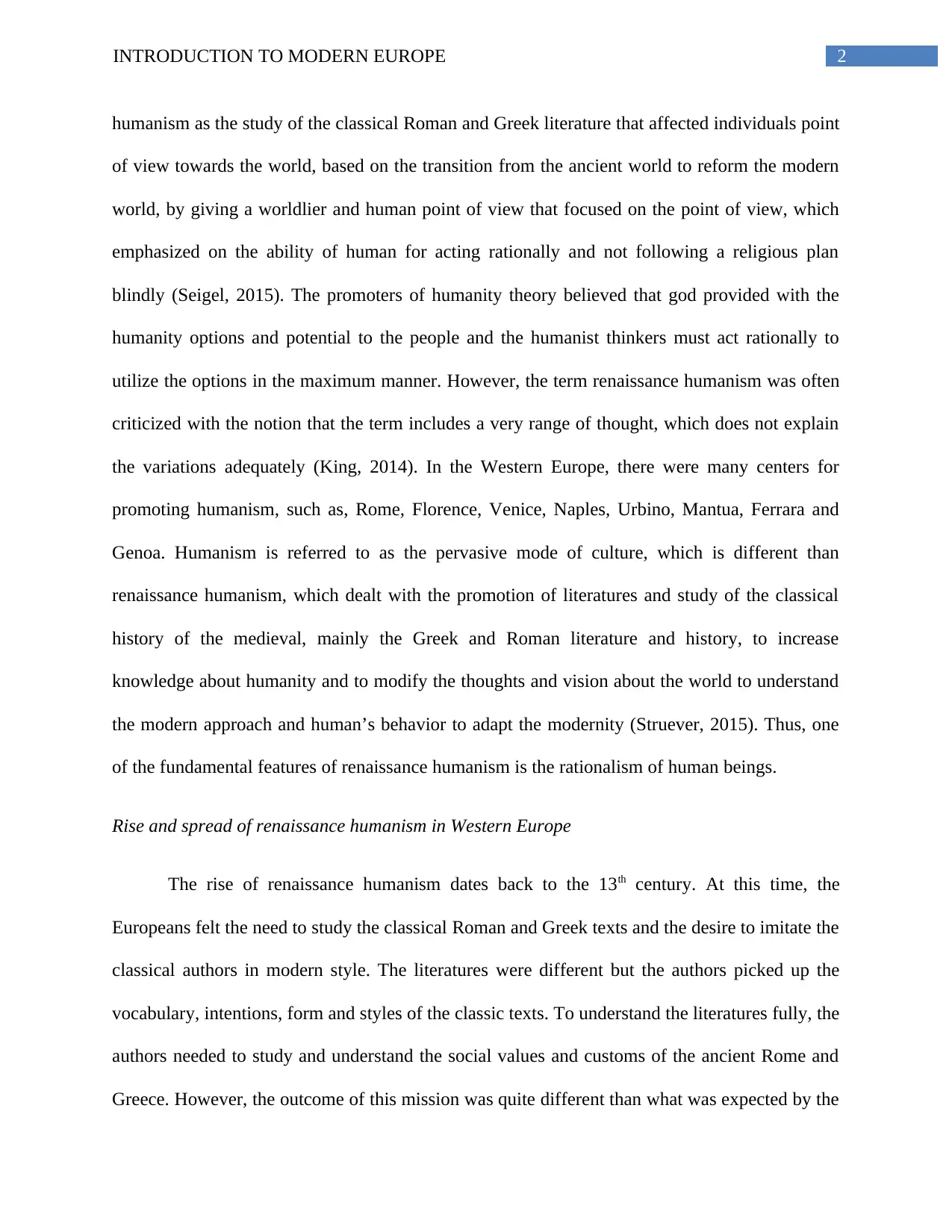
2INTRODUCTION TO MODERN EUROPE
humanism as the study of the classical Roman and Greek literature that affected individuals point
of view towards the world, based on the transition from the ancient world to reform the modern
world, by giving a worldlier and human point of view that focused on the point of view, which
emphasized on the ability of human for acting rationally and not following a religious plan
blindly (Seigel, 2015). The promoters of humanity theory believed that god provided with the
humanity options and potential to the people and the humanist thinkers must act rationally to
utilize the options in the maximum manner. However, the term renaissance humanism was often
criticized with the notion that the term includes a very range of thought, which does not explain
the variations adequately (King, 2014). In the Western Europe, there were many centers for
promoting humanism, such as, Rome, Florence, Venice, Naples, Urbino, Mantua, Ferrara and
Genoa. Humanism is referred to as the pervasive mode of culture, which is different than
renaissance humanism, which dealt with the promotion of literatures and study of the classical
history of the medieval, mainly the Greek and Roman literature and history, to increase
knowledge about humanity and to modify the thoughts and vision about the world to understand
the modern approach and human’s behavior to adapt the modernity (Struever, 2015). Thus, one
of the fundamental features of renaissance humanism is the rationalism of human beings.
Rise and spread of renaissance humanism in Western Europe
The rise of renaissance humanism dates back to the 13th century. At this time, the
Europeans felt the need to study the classical Roman and Greek texts and the desire to imitate the
classical authors in modern style. The literatures were different but the authors picked up the
vocabulary, intentions, form and styles of the classic texts. To understand the literatures fully, the
authors needed to study and understand the social values and customs of the ancient Rome and
Greece. However, the outcome of this mission was quite different than what was expected by the
humanism as the study of the classical Roman and Greek literature that affected individuals point
of view towards the world, based on the transition from the ancient world to reform the modern
world, by giving a worldlier and human point of view that focused on the point of view, which
emphasized on the ability of human for acting rationally and not following a religious plan
blindly (Seigel, 2015). The promoters of humanity theory believed that god provided with the
humanity options and potential to the people and the humanist thinkers must act rationally to
utilize the options in the maximum manner. However, the term renaissance humanism was often
criticized with the notion that the term includes a very range of thought, which does not explain
the variations adequately (King, 2014). In the Western Europe, there were many centers for
promoting humanism, such as, Rome, Florence, Venice, Naples, Urbino, Mantua, Ferrara and
Genoa. Humanism is referred to as the pervasive mode of culture, which is different than
renaissance humanism, which dealt with the promotion of literatures and study of the classical
history of the medieval, mainly the Greek and Roman literature and history, to increase
knowledge about humanity and to modify the thoughts and vision about the world to understand
the modern approach and human’s behavior to adapt the modernity (Struever, 2015). Thus, one
of the fundamental features of renaissance humanism is the rationalism of human beings.
Rise and spread of renaissance humanism in Western Europe
The rise of renaissance humanism dates back to the 13th century. At this time, the
Europeans felt the need to study the classical Roman and Greek texts and the desire to imitate the
classical authors in modern style. The literatures were different but the authors picked up the
vocabulary, intentions, form and styles of the classic texts. To understand the literatures fully, the
authors needed to study and understand the social values and customs of the ancient Rome and
Greece. However, the outcome of this mission was quite different than what was expected by the
⊘ This is a preview!⊘
Do you want full access?
Subscribe today to unlock all pages.

Trusted by 1+ million students worldwide
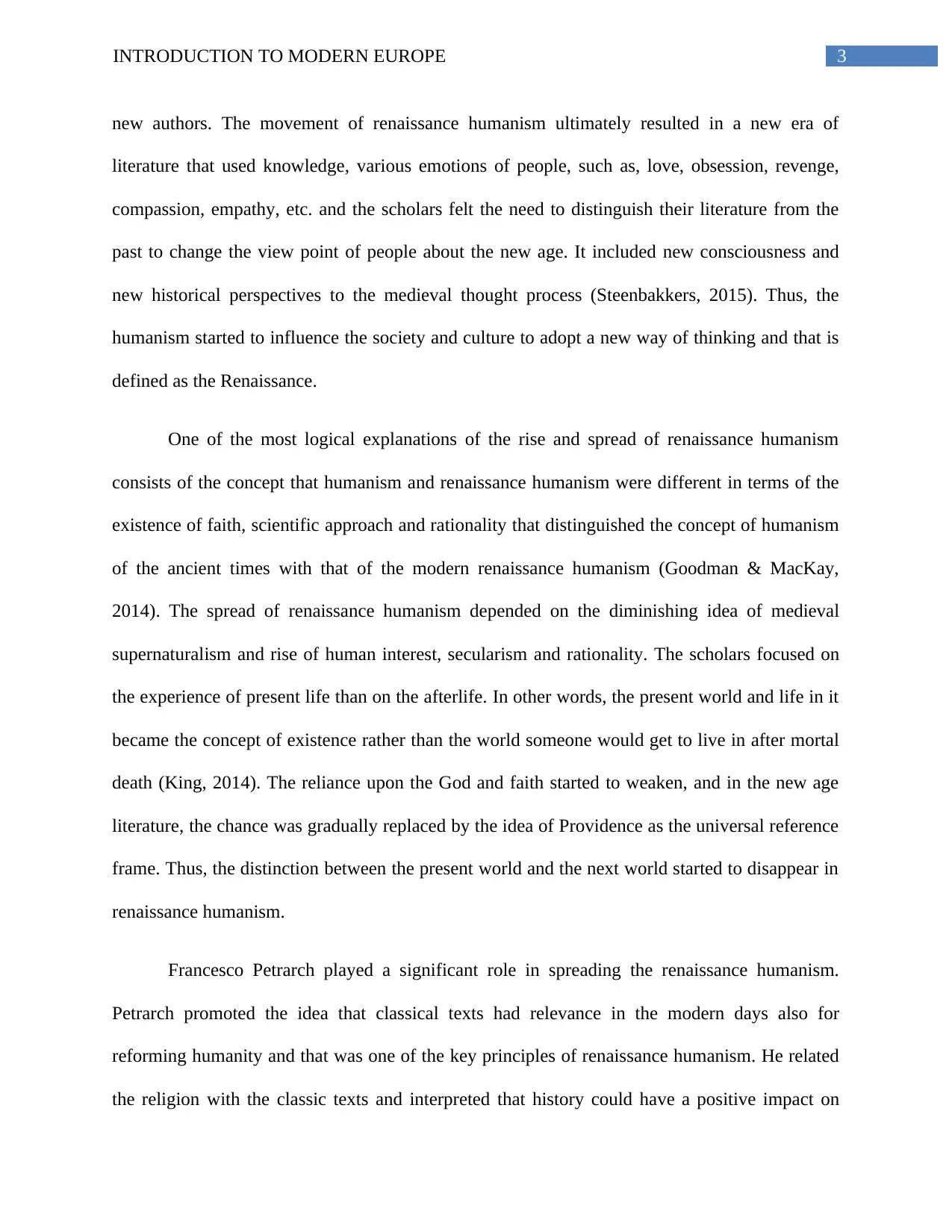
3INTRODUCTION TO MODERN EUROPE
new authors. The movement of renaissance humanism ultimately resulted in a new era of
literature that used knowledge, various emotions of people, such as, love, obsession, revenge,
compassion, empathy, etc. and the scholars felt the need to distinguish their literature from the
past to change the view point of people about the new age. It included new consciousness and
new historical perspectives to the medieval thought process (Steenbakkers, 2015). Thus, the
humanism started to influence the society and culture to adopt a new way of thinking and that is
defined as the Renaissance.
One of the most logical explanations of the rise and spread of renaissance humanism
consists of the concept that humanism and renaissance humanism were different in terms of the
existence of faith, scientific approach and rationality that distinguished the concept of humanism
of the ancient times with that of the modern renaissance humanism (Goodman & MacKay,
2014). The spread of renaissance humanism depended on the diminishing idea of medieval
supernaturalism and rise of human interest, secularism and rationality. The scholars focused on
the experience of present life than on the afterlife. In other words, the present world and life in it
became the concept of existence rather than the world someone would get to live in after mortal
death (King, 2014). The reliance upon the God and faith started to weaken, and in the new age
literature, the chance was gradually replaced by the idea of Providence as the universal reference
frame. Thus, the distinction between the present world and the next world started to disappear in
renaissance humanism.
Francesco Petrarch played a significant role in spreading the renaissance humanism.
Petrarch promoted the idea that classical texts had relevance in the modern days also for
reforming humanity and that was one of the key principles of renaissance humanism. He related
the religion with the classic texts and interpreted that history could have a positive impact on
new authors. The movement of renaissance humanism ultimately resulted in a new era of
literature that used knowledge, various emotions of people, such as, love, obsession, revenge,
compassion, empathy, etc. and the scholars felt the need to distinguish their literature from the
past to change the view point of people about the new age. It included new consciousness and
new historical perspectives to the medieval thought process (Steenbakkers, 2015). Thus, the
humanism started to influence the society and culture to adopt a new way of thinking and that is
defined as the Renaissance.
One of the most logical explanations of the rise and spread of renaissance humanism
consists of the concept that humanism and renaissance humanism were different in terms of the
existence of faith, scientific approach and rationality that distinguished the concept of humanism
of the ancient times with that of the modern renaissance humanism (Goodman & MacKay,
2014). The spread of renaissance humanism depended on the diminishing idea of medieval
supernaturalism and rise of human interest, secularism and rationality. The scholars focused on
the experience of present life than on the afterlife. In other words, the present world and life in it
became the concept of existence rather than the world someone would get to live in after mortal
death (King, 2014). The reliance upon the God and faith started to weaken, and in the new age
literature, the chance was gradually replaced by the idea of Providence as the universal reference
frame. Thus, the distinction between the present world and the next world started to disappear in
renaissance humanism.
Francesco Petrarch played a significant role in spreading the renaissance humanism.
Petrarch promoted the idea that classical texts had relevance in the modern days also for
reforming humanity and that was one of the key principles of renaissance humanism. He related
the religion with the classic texts and interpreted that history could have a positive impact on
Paraphrase This Document
Need a fresh take? Get an instant paraphrase of this document with our AI Paraphraser
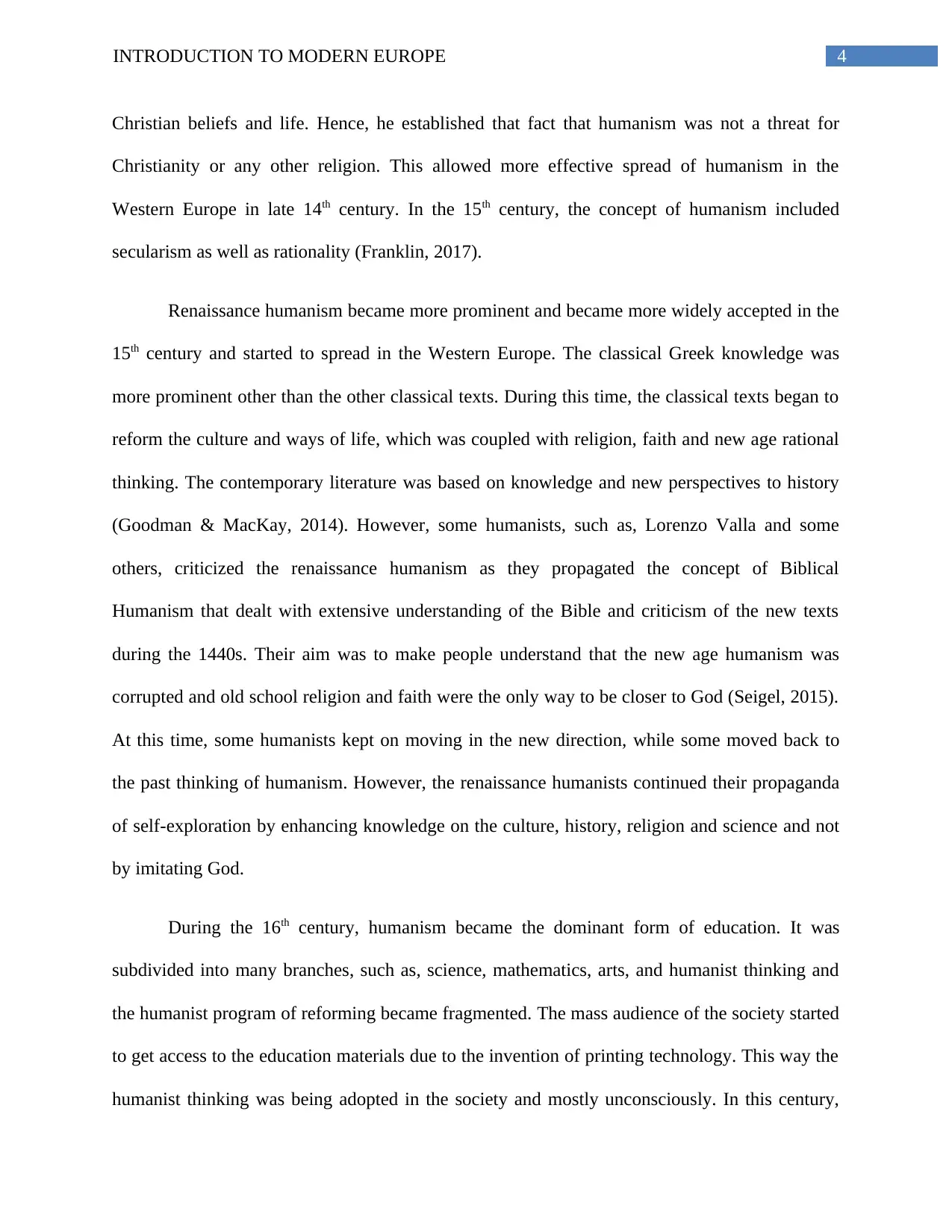
4INTRODUCTION TO MODERN EUROPE
Christian beliefs and life. Hence, he established that fact that humanism was not a threat for
Christianity or any other religion. This allowed more effective spread of humanism in the
Western Europe in late 14th century. In the 15th century, the concept of humanism included
secularism as well as rationality (Franklin, 2017).
Renaissance humanism became more prominent and became more widely accepted in the
15th century and started to spread in the Western Europe. The classical Greek knowledge was
more prominent other than the other classical texts. During this time, the classical texts began to
reform the culture and ways of life, which was coupled with religion, faith and new age rational
thinking. The contemporary literature was based on knowledge and new perspectives to history
(Goodman & MacKay, 2014). However, some humanists, such as, Lorenzo Valla and some
others, criticized the renaissance humanism as they propagated the concept of Biblical
Humanism that dealt with extensive understanding of the Bible and criticism of the new texts
during the 1440s. Their aim was to make people understand that the new age humanism was
corrupted and old school religion and faith were the only way to be closer to God (Seigel, 2015).
At this time, some humanists kept on moving in the new direction, while some moved back to
the past thinking of humanism. However, the renaissance humanists continued their propaganda
of self-exploration by enhancing knowledge on the culture, history, religion and science and not
by imitating God.
During the 16th century, humanism became the dominant form of education. It was
subdivided into many branches, such as, science, mathematics, arts, and humanist thinking and
the humanist program of reforming became fragmented. The mass audience of the society started
to get access to the education materials due to the invention of printing technology. This way the
humanist thinking was being adopted in the society and mostly unconsciously. In this century,
Christian beliefs and life. Hence, he established that fact that humanism was not a threat for
Christianity or any other religion. This allowed more effective spread of humanism in the
Western Europe in late 14th century. In the 15th century, the concept of humanism included
secularism as well as rationality (Franklin, 2017).
Renaissance humanism became more prominent and became more widely accepted in the
15th century and started to spread in the Western Europe. The classical Greek knowledge was
more prominent other than the other classical texts. During this time, the classical texts began to
reform the culture and ways of life, which was coupled with religion, faith and new age rational
thinking. The contemporary literature was based on knowledge and new perspectives to history
(Goodman & MacKay, 2014). However, some humanists, such as, Lorenzo Valla and some
others, criticized the renaissance humanism as they propagated the concept of Biblical
Humanism that dealt with extensive understanding of the Bible and criticism of the new texts
during the 1440s. Their aim was to make people understand that the new age humanism was
corrupted and old school religion and faith were the only way to be closer to God (Seigel, 2015).
At this time, some humanists kept on moving in the new direction, while some moved back to
the past thinking of humanism. However, the renaissance humanists continued their propaganda
of self-exploration by enhancing knowledge on the culture, history, religion and science and not
by imitating God.
During the 16th century, humanism became the dominant form of education. It was
subdivided into many branches, such as, science, mathematics, arts, and humanist thinking and
the humanist program of reforming became fragmented. The mass audience of the society started
to get access to the education materials due to the invention of printing technology. This way the
humanist thinking was being adopted in the society and mostly unconsciously. In this century,
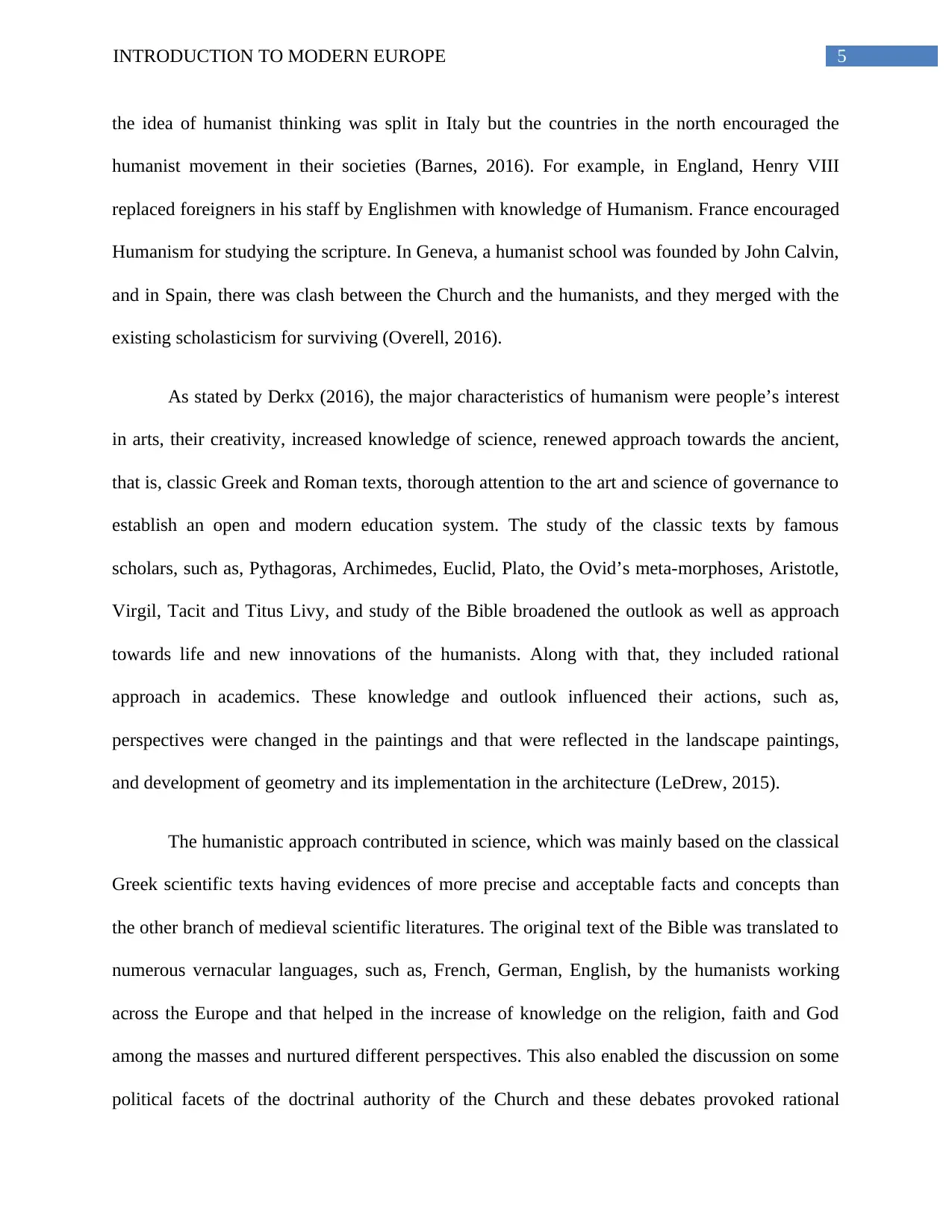
5INTRODUCTION TO MODERN EUROPE
the idea of humanist thinking was split in Italy but the countries in the north encouraged the
humanist movement in their societies (Barnes, 2016). For example, in England, Henry VIII
replaced foreigners in his staff by Englishmen with knowledge of Humanism. France encouraged
Humanism for studying the scripture. In Geneva, a humanist school was founded by John Calvin,
and in Spain, there was clash between the Church and the humanists, and they merged with the
existing scholasticism for surviving (Overell, 2016).
As stated by Derkx (2016), the major characteristics of humanism were people’s interest
in arts, their creativity, increased knowledge of science, renewed approach towards the ancient,
that is, classic Greek and Roman texts, thorough attention to the art and science of governance to
establish an open and modern education system. The study of the classic texts by famous
scholars, such as, Pythagoras, Archimedes, Euclid, Plato, the Ovid’s meta-morphoses, Aristotle,
Virgil, Tacit and Titus Livy, and study of the Bible broadened the outlook as well as approach
towards life and new innovations of the humanists. Along with that, they included rational
approach in academics. These knowledge and outlook influenced their actions, such as,
perspectives were changed in the paintings and that were reflected in the landscape paintings,
and development of geometry and its implementation in the architecture (LeDrew, 2015).
The humanistic approach contributed in science, which was mainly based on the classical
Greek scientific texts having evidences of more precise and acceptable facts and concepts than
the other branch of medieval scientific literatures. The original text of the Bible was translated to
numerous vernacular languages, such as, French, German, English, by the humanists working
across the Europe and that helped in the increase of knowledge on the religion, faith and God
among the masses and nurtured different perspectives. This also enabled the discussion on some
political facets of the doctrinal authority of the Church and these debates provoked rational
the idea of humanist thinking was split in Italy but the countries in the north encouraged the
humanist movement in their societies (Barnes, 2016). For example, in England, Henry VIII
replaced foreigners in his staff by Englishmen with knowledge of Humanism. France encouraged
Humanism for studying the scripture. In Geneva, a humanist school was founded by John Calvin,
and in Spain, there was clash between the Church and the humanists, and they merged with the
existing scholasticism for surviving (Overell, 2016).
As stated by Derkx (2016), the major characteristics of humanism were people’s interest
in arts, their creativity, increased knowledge of science, renewed approach towards the ancient,
that is, classic Greek and Roman texts, thorough attention to the art and science of governance to
establish an open and modern education system. The study of the classic texts by famous
scholars, such as, Pythagoras, Archimedes, Euclid, Plato, the Ovid’s meta-morphoses, Aristotle,
Virgil, Tacit and Titus Livy, and study of the Bible broadened the outlook as well as approach
towards life and new innovations of the humanists. Along with that, they included rational
approach in academics. These knowledge and outlook influenced their actions, such as,
perspectives were changed in the paintings and that were reflected in the landscape paintings,
and development of geometry and its implementation in the architecture (LeDrew, 2015).
The humanistic approach contributed in science, which was mainly based on the classical
Greek scientific texts having evidences of more precise and acceptable facts and concepts than
the other branch of medieval scientific literatures. The original text of the Bible was translated to
numerous vernacular languages, such as, French, German, English, by the humanists working
across the Europe and that helped in the increase of knowledge on the religion, faith and God
among the masses and nurtured different perspectives. This also enabled the discussion on some
political facets of the doctrinal authority of the Church and these debates provoked rational
⊘ This is a preview!⊘
Do you want full access?
Subscribe today to unlock all pages.

Trusted by 1+ million students worldwide
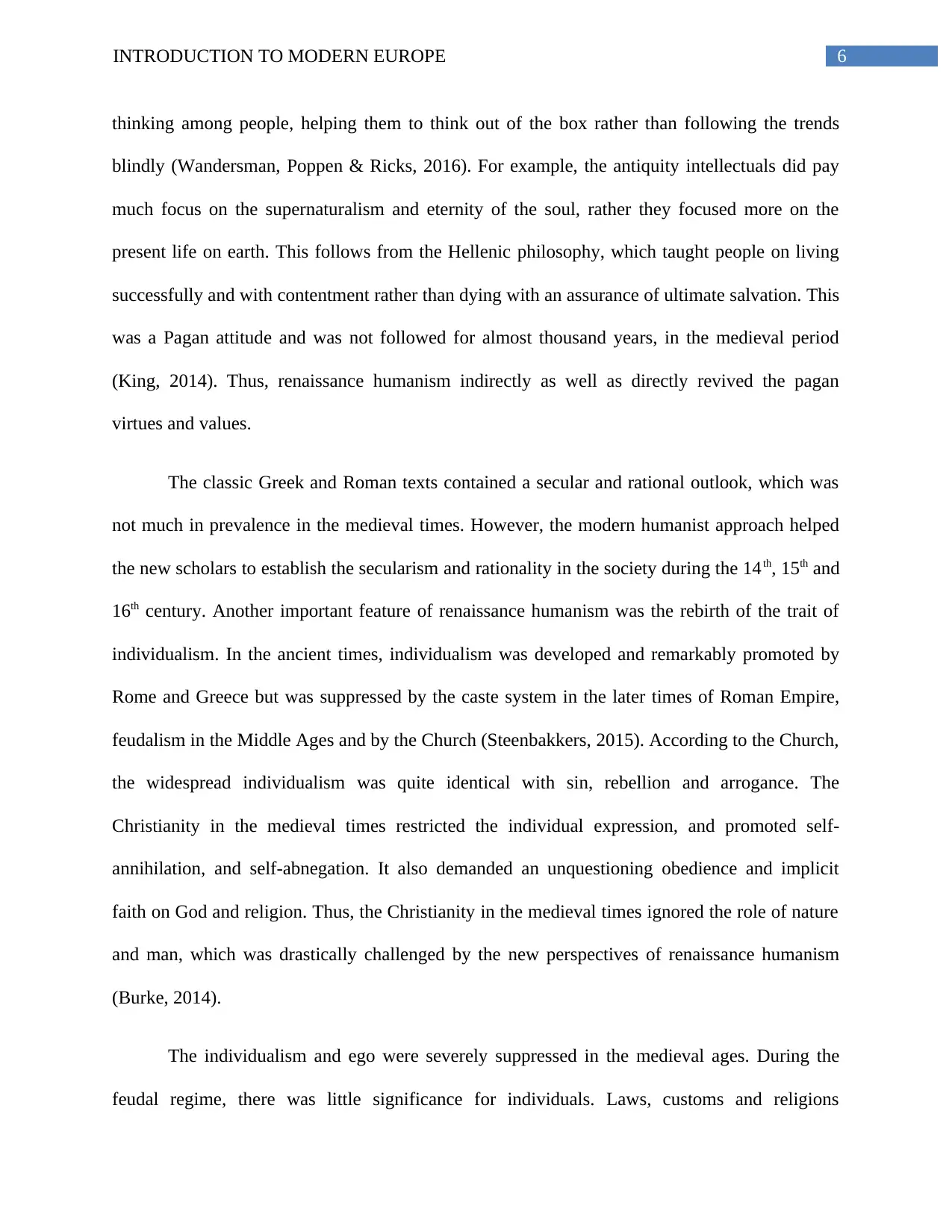
6INTRODUCTION TO MODERN EUROPE
thinking among people, helping them to think out of the box rather than following the trends
blindly (Wandersman, Poppen & Ricks, 2016). For example, the antiquity intellectuals did pay
much focus on the supernaturalism and eternity of the soul, rather they focused more on the
present life on earth. This follows from the Hellenic philosophy, which taught people on living
successfully and with contentment rather than dying with an assurance of ultimate salvation. This
was a Pagan attitude and was not followed for almost thousand years, in the medieval period
(King, 2014). Thus, renaissance humanism indirectly as well as directly revived the pagan
virtues and values.
The classic Greek and Roman texts contained a secular and rational outlook, which was
not much in prevalence in the medieval times. However, the modern humanist approach helped
the new scholars to establish the secularism and rationality in the society during the 14th, 15th and
16th century. Another important feature of renaissance humanism was the rebirth of the trait of
individualism. In the ancient times, individualism was developed and remarkably promoted by
Rome and Greece but was suppressed by the caste system in the later times of Roman Empire,
feudalism in the Middle Ages and by the Church (Steenbakkers, 2015). According to the Church,
the widespread individualism was quite identical with sin, rebellion and arrogance. The
Christianity in the medieval times restricted the individual expression, and promoted self-
annihilation, and self-abnegation. It also demanded an unquestioning obedience and implicit
faith on God and religion. Thus, the Christianity in the medieval times ignored the role of nature
and man, which was drastically challenged by the new perspectives of renaissance humanism
(Burke, 2014).
The individualism and ego were severely suppressed in the medieval ages. During the
feudal regime, there was little significance for individuals. Laws, customs and religions
thinking among people, helping them to think out of the box rather than following the trends
blindly (Wandersman, Poppen & Ricks, 2016). For example, the antiquity intellectuals did pay
much focus on the supernaturalism and eternity of the soul, rather they focused more on the
present life on earth. This follows from the Hellenic philosophy, which taught people on living
successfully and with contentment rather than dying with an assurance of ultimate salvation. This
was a Pagan attitude and was not followed for almost thousand years, in the medieval period
(King, 2014). Thus, renaissance humanism indirectly as well as directly revived the pagan
virtues and values.
The classic Greek and Roman texts contained a secular and rational outlook, which was
not much in prevalence in the medieval times. However, the modern humanist approach helped
the new scholars to establish the secularism and rationality in the society during the 14th, 15th and
16th century. Another important feature of renaissance humanism was the rebirth of the trait of
individualism. In the ancient times, individualism was developed and remarkably promoted by
Rome and Greece but was suppressed by the caste system in the later times of Roman Empire,
feudalism in the Middle Ages and by the Church (Steenbakkers, 2015). According to the Church,
the widespread individualism was quite identical with sin, rebellion and arrogance. The
Christianity in the medieval times restricted the individual expression, and promoted self-
annihilation, and self-abnegation. It also demanded an unquestioning obedience and implicit
faith on God and religion. Thus, the Christianity in the medieval times ignored the role of nature
and man, which was drastically challenged by the new perspectives of renaissance humanism
(Burke, 2014).
The individualism and ego were severely suppressed in the medieval ages. During the
feudal regime, there was little significance for individuals. Laws, customs and religions
Paraphrase This Document
Need a fresh take? Get an instant paraphrase of this document with our AI Paraphraser
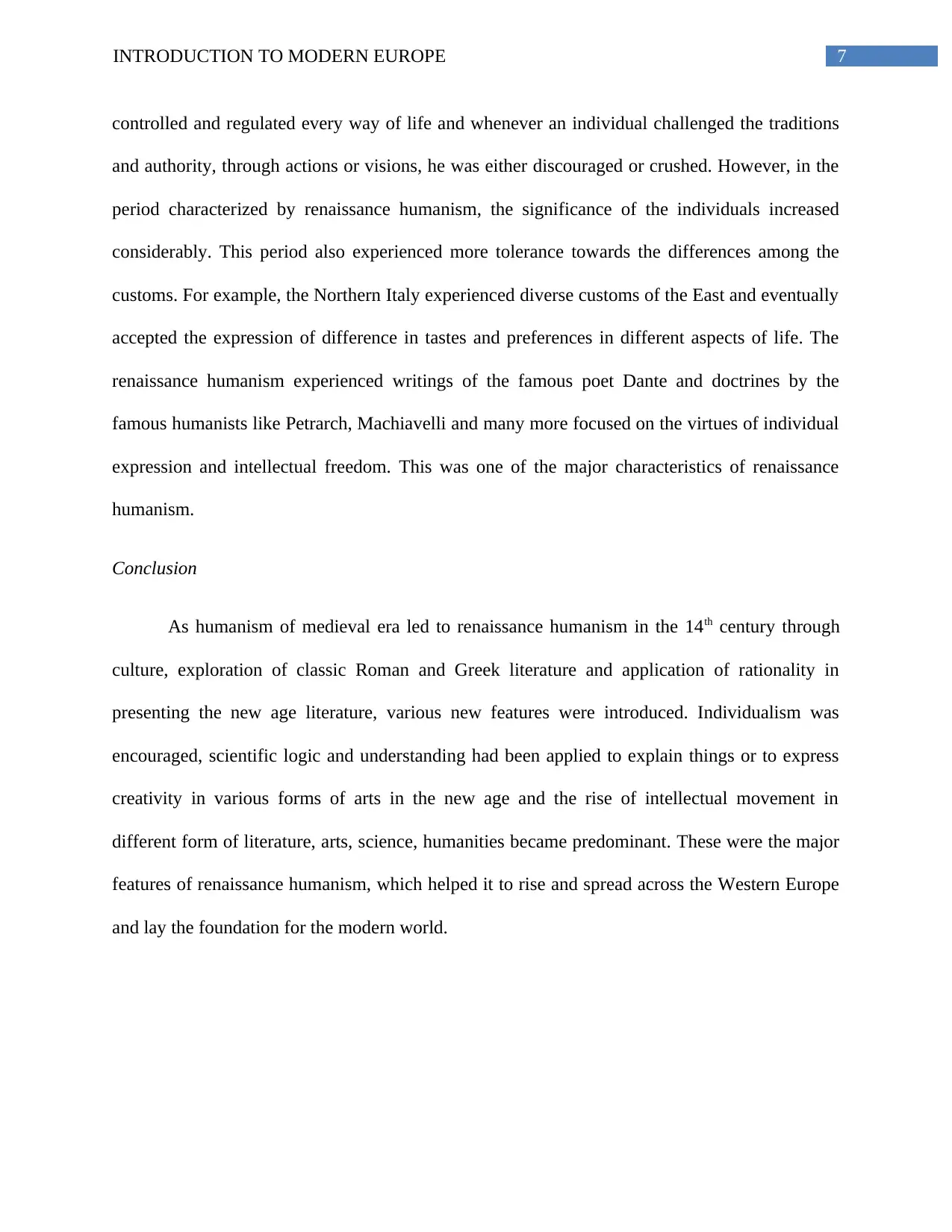
7INTRODUCTION TO MODERN EUROPE
controlled and regulated every way of life and whenever an individual challenged the traditions
and authority, through actions or visions, he was either discouraged or crushed. However, in the
period characterized by renaissance humanism, the significance of the individuals increased
considerably. This period also experienced more tolerance towards the differences among the
customs. For example, the Northern Italy experienced diverse customs of the East and eventually
accepted the expression of difference in tastes and preferences in different aspects of life. The
renaissance humanism experienced writings of the famous poet Dante and doctrines by the
famous humanists like Petrarch, Machiavelli and many more focused on the virtues of individual
expression and intellectual freedom. This was one of the major characteristics of renaissance
humanism.
Conclusion
As humanism of medieval era led to renaissance humanism in the 14th century through
culture, exploration of classic Roman and Greek literature and application of rationality in
presenting the new age literature, various new features were introduced. Individualism was
encouraged, scientific logic and understanding had been applied to explain things or to express
creativity in various forms of arts in the new age and the rise of intellectual movement in
different form of literature, arts, science, humanities became predominant. These were the major
features of renaissance humanism, which helped it to rise and spread across the Western Europe
and lay the foundation for the modern world.
controlled and regulated every way of life and whenever an individual challenged the traditions
and authority, through actions or visions, he was either discouraged or crushed. However, in the
period characterized by renaissance humanism, the significance of the individuals increased
considerably. This period also experienced more tolerance towards the differences among the
customs. For example, the Northern Italy experienced diverse customs of the East and eventually
accepted the expression of difference in tastes and preferences in different aspects of life. The
renaissance humanism experienced writings of the famous poet Dante and doctrines by the
famous humanists like Petrarch, Machiavelli and many more focused on the virtues of individual
expression and intellectual freedom. This was one of the major characteristics of renaissance
humanism.
Conclusion
As humanism of medieval era led to renaissance humanism in the 14th century through
culture, exploration of classic Roman and Greek literature and application of rationality in
presenting the new age literature, various new features were introduced. Individualism was
encouraged, scientific logic and understanding had been applied to explain things or to express
creativity in various forms of arts in the new age and the rise of intellectual movement in
different form of literature, arts, science, humanities became predominant. These were the major
features of renaissance humanism, which helped it to rise and spread across the Western Europe
and lay the foundation for the modern world.
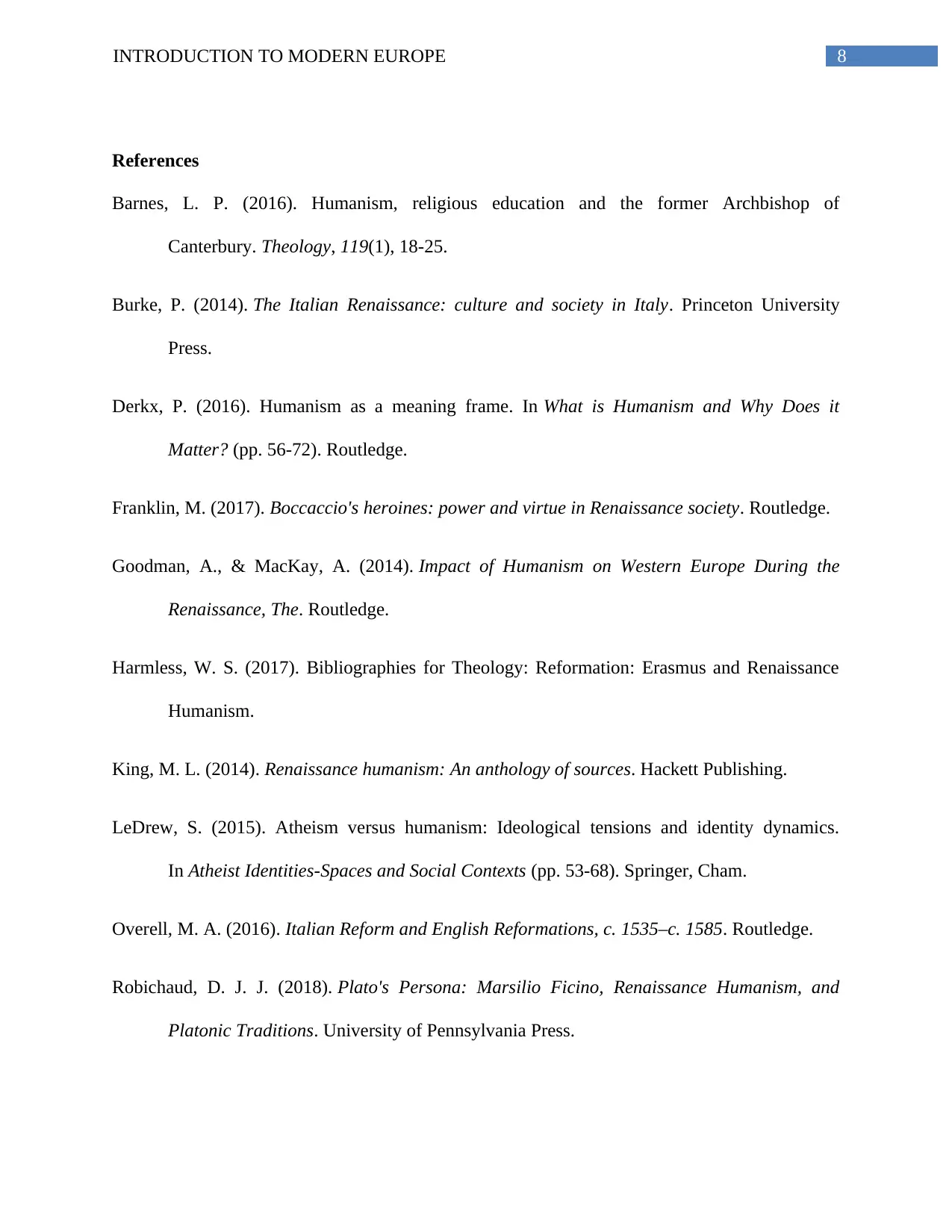
8INTRODUCTION TO MODERN EUROPE
References
Barnes, L. P. (2016). Humanism, religious education and the former Archbishop of
Canterbury. Theology, 119(1), 18-25.
Burke, P. (2014). The Italian Renaissance: culture and society in Italy. Princeton University
Press.
Derkx, P. (2016). Humanism as a meaning frame. In What is Humanism and Why Does it
Matter? (pp. 56-72). Routledge.
Franklin, M. (2017). Boccaccio's heroines: power and virtue in Renaissance society. Routledge.
Goodman, A., & MacKay, A. (2014). Impact of Humanism on Western Europe During the
Renaissance, The. Routledge.
Harmless, W. S. (2017). Bibliographies for Theology: Reformation: Erasmus and Renaissance
Humanism.
King, M. L. (2014). Renaissance humanism: An anthology of sources. Hackett Publishing.
LeDrew, S. (2015). Atheism versus humanism: Ideological tensions and identity dynamics.
In Atheist Identities-Spaces and Social Contexts (pp. 53-68). Springer, Cham.
Overell, M. A. (2016). Italian Reform and English Reformations, c. 1535–c. 1585. Routledge.
Robichaud, D. J. J. (2018). Plato's Persona: Marsilio Ficino, Renaissance Humanism, and
Platonic Traditions. University of Pennsylvania Press.
References
Barnes, L. P. (2016). Humanism, religious education and the former Archbishop of
Canterbury. Theology, 119(1), 18-25.
Burke, P. (2014). The Italian Renaissance: culture and society in Italy. Princeton University
Press.
Derkx, P. (2016). Humanism as a meaning frame. In What is Humanism and Why Does it
Matter? (pp. 56-72). Routledge.
Franklin, M. (2017). Boccaccio's heroines: power and virtue in Renaissance society. Routledge.
Goodman, A., & MacKay, A. (2014). Impact of Humanism on Western Europe During the
Renaissance, The. Routledge.
Harmless, W. S. (2017). Bibliographies for Theology: Reformation: Erasmus and Renaissance
Humanism.
King, M. L. (2014). Renaissance humanism: An anthology of sources. Hackett Publishing.
LeDrew, S. (2015). Atheism versus humanism: Ideological tensions and identity dynamics.
In Atheist Identities-Spaces and Social Contexts (pp. 53-68). Springer, Cham.
Overell, M. A. (2016). Italian Reform and English Reformations, c. 1535–c. 1585. Routledge.
Robichaud, D. J. J. (2018). Plato's Persona: Marsilio Ficino, Renaissance Humanism, and
Platonic Traditions. University of Pennsylvania Press.
⊘ This is a preview!⊘
Do you want full access?
Subscribe today to unlock all pages.

Trusted by 1+ million students worldwide
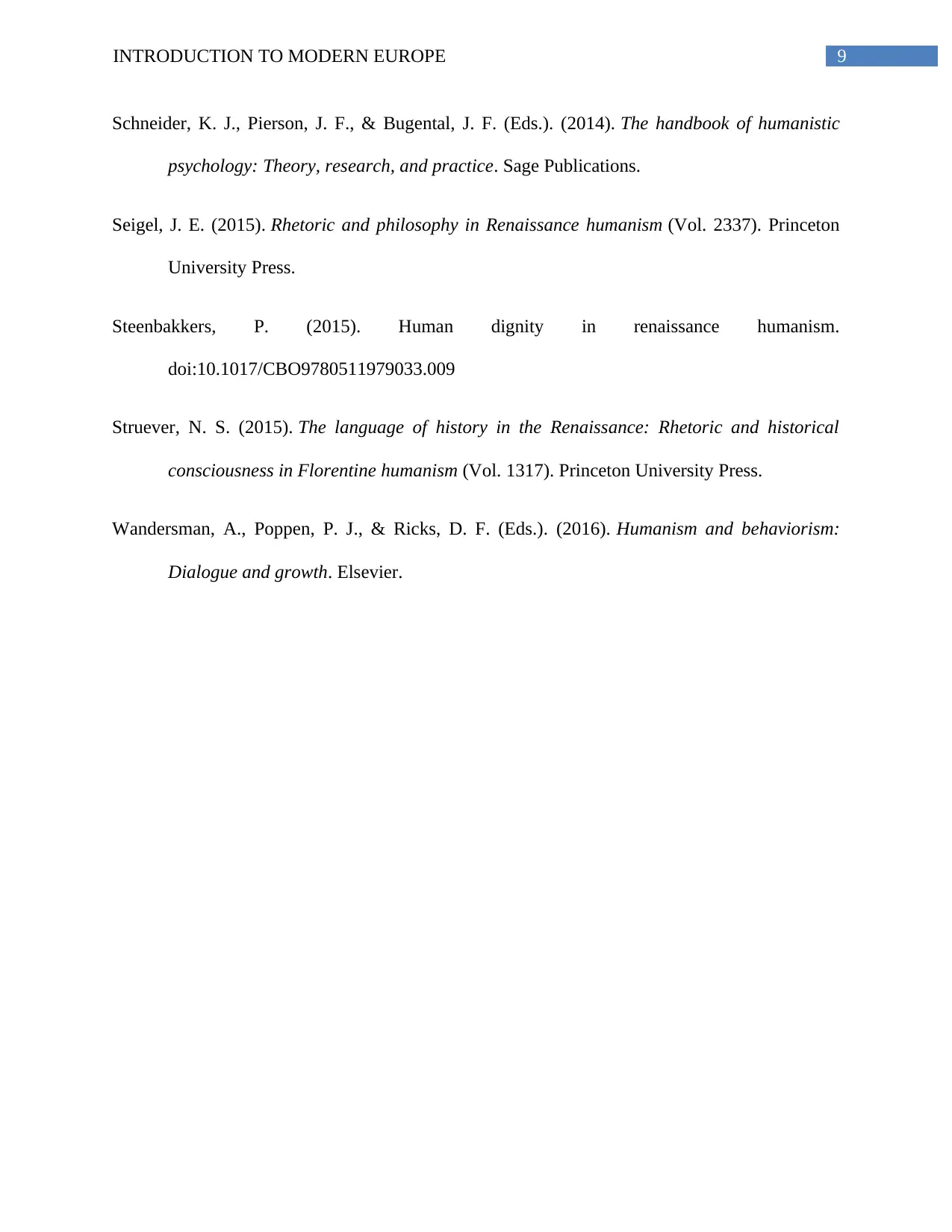
9INTRODUCTION TO MODERN EUROPE
Schneider, K. J., Pierson, J. F., & Bugental, J. F. (Eds.). (2014). The handbook of humanistic
psychology: Theory, research, and practice. Sage Publications.
Seigel, J. E. (2015). Rhetoric and philosophy in Renaissance humanism (Vol. 2337). Princeton
University Press.
Steenbakkers, P. (2015). Human dignity in renaissance humanism.
doi:10.1017/CBO9780511979033.009
Struever, N. S. (2015). The language of history in the Renaissance: Rhetoric and historical
consciousness in Florentine humanism (Vol. 1317). Princeton University Press.
Wandersman, A., Poppen, P. J., & Ricks, D. F. (Eds.). (2016). Humanism and behaviorism:
Dialogue and growth. Elsevier.
Schneider, K. J., Pierson, J. F., & Bugental, J. F. (Eds.). (2014). The handbook of humanistic
psychology: Theory, research, and practice. Sage Publications.
Seigel, J. E. (2015). Rhetoric and philosophy in Renaissance humanism (Vol. 2337). Princeton
University Press.
Steenbakkers, P. (2015). Human dignity in renaissance humanism.
doi:10.1017/CBO9780511979033.009
Struever, N. S. (2015). The language of history in the Renaissance: Rhetoric and historical
consciousness in Florentine humanism (Vol. 1317). Princeton University Press.
Wandersman, A., Poppen, P. J., & Ricks, D. F. (Eds.). (2016). Humanism and behaviorism:
Dialogue and growth. Elsevier.
1 out of 10
Related Documents
Your All-in-One AI-Powered Toolkit for Academic Success.
+13062052269
info@desklib.com
Available 24*7 on WhatsApp / Email
![[object Object]](/_next/static/media/star-bottom.7253800d.svg)
Unlock your academic potential
Copyright © 2020–2025 A2Z Services. All Rights Reserved. Developed and managed by ZUCOL.





